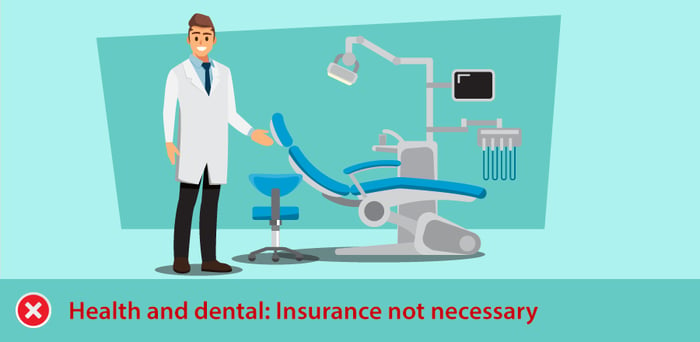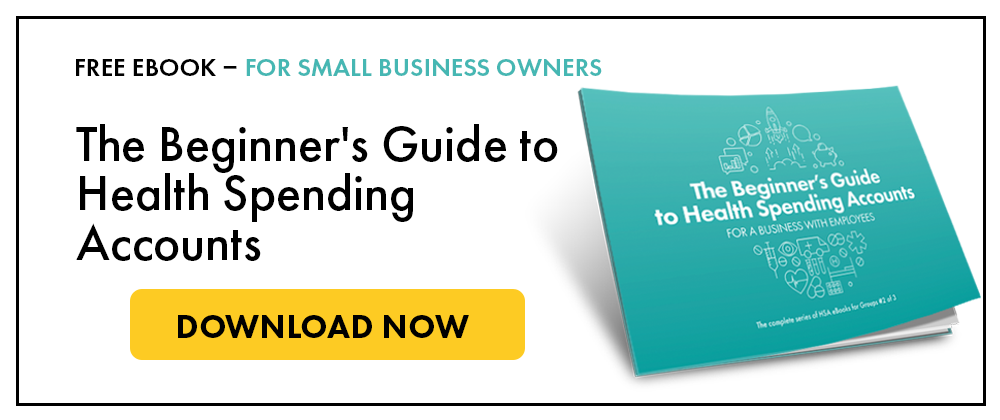Despite what your intuition tells you, private health insurance hurts more than it helps. We've done the research and found that in most cases, you'll lose money by buying insurance. That's why Canada offers a cost-effective alternative to traditional insurance plans that can benefit both incorporated small businesses and individuals - the Health Spending Account.
Note: The value of an insurance plan cannot be evaluated without knowing all the details (copay, pre-existing conditions, premiums, deductibles, etc.) The advice we provide is based on our past experience with insurance providers and thousands of small business owners.
In general, you’ll lose money by buying health and dental insurance.
Private health insurance was created to cushion medical costs not typically covered by the provincial plan. This means expenses like dental, vision, physiotherapy, prescription drugs, massages and more. But the matter of fact is that in most cases, you'll lose money by buying health insurance.
These types of plans are not cost effective for individuals or small businesses. Pooling only takes effect in large corporations with more than 500 employees.
The purpose of insurance is to protect you from unknown, potentially catastrophic events. While driving a car, you cannot predict a crash, and so you choose to insure your car. This element of risk is what instigates a need for insurance.

Similarly, you might think to insure your health and dental on the low chance of a financially catastrophic event. This is a misconception that health insurance uses to prey on its customers.

Let's delve deeper into the element of risk, specifically financial vs. physical risk:
The provincial healthcare plan covers life threatening emergencies (physical risks). The only justification for health insurance is if a person faces a (financially catastrophic) medical expense such as a $10,000 dental bill, but here’s the catch - your insurance provider wouldn't cover this expense anyway.
A private health insurance plan has built in premiums, copay, deductible, and coverage limits based on each respective medical expense. These terms favor the insurer and keep them profitable in the long run. It means your provider will only cover costs over a certain amount (deductible) and will not reimburse you over a certain amount (limits). You can see how this kind of scenario is limiting.
Example: deductible of $500 and coverage limit of $2,000. This means an expense of $10,000 requires you to pay the first $500, and then insurance steps in to cover $2,000. What remains of the $10,000 bill is on you.
If you exceed your premiums paid out each year, expect insurance providers to raise your premiums the following year to make up for lost profits.
There is no winning scenario.
Insurance carriers will typically take in more premiums than they pay out. That's how they make money. That's how they keep their business running.
Why pay more for medical expenses through an insurance provider when you could just save your money in a High Interest Savings Account and pay the upfront costs to your dentist or medical service provider?
This is a fundamental question not asked by most Canadians.
Health and dental expenses are typically maintenance or planned events, like going to the dentist for a routine checkup. If you are taking care of your health, you aren't likely to be hit with an unexpected $10,000 dental bill on your next appointment.
Insurance companies are founded on economies of scale. This means plans are programmed to become more affordable as you increase the number of employees. This model of business is a huge cost burden for small businesses. Under these plans, small business owners find that the premiums will quickly surpass their intended benefits.
There is a cost-effective alternative to health insurance:
Small businesses and the self-employed can still get affordable health and dental coverage through a Health Spending Account (HSA). The HSA is an employee benefits plan which lets your corporation provide tax free health and dental dollars to its employees. At the same time, the costs are a tax deduction for the business. It works for both single person business and a business with one or more arm’s length employees.

One of the greatest advantages of using a Health Spending Account is cost control.
You will never lose money to unrecoverable premiums during a year with low employee claims. A HSA is a self-funded plan which lets the company directly control its employee benefits.
In a traditional insurance plan, the company pays premiums, and the insurance provider reimburses the company's employees with limited coverage. The company never gets their premium back and never knows if employees are fully covered.
To continue your research on a HSA, consider reading our comparison of health insurance and a Health Spending Account
Learn how a HSA can work as a win-win employee benefits package:

Common Health Insurance Terminology
Knowing common insurance terms can help to evaluate your plan:
What is a premium?
A premium is a re-occurring (typically monthly) payment charged by insurance companies to their clients. With a premium, you have to pay regardless of whether you use the plan or not. This is not very convenient for those who don’t claim often. As well, the premium may increase based on your past claims or your coworker's claims.
What is a deductible?
A deductible is the base amount you must pay (during a given time period, for example, yearly) before your insurance carrier is going to step in. In other words, you must pay up to an amount (on the health expense) before the insurer contributes. If your deductible is $100 and the dentist checkup was $300, then you must pay for the first $100 of the $300, leaving $200 for insurance to cover. Keep in mind, there may also be co-insurance and co-pay terms built into your plan. These additional costs come into play after your deductible is met. Very few insurance carriers offer plans which cover 100% of medical costs.
What is pooling?
Pooling is the minimizing of risk by grouping individuals together so that unpredictable individual financial risk becomes predictable. Entry into the pool is usually through a premium which is distributed among all members of the pool. In private insurance plans, benefits or distributions are typically pre-defined. In general, a corporation with more employees equals a larger pool and lower price sensitivity in the event of a claim. Additionally, larger pooling (between companies) only takes effect on claims over a specified amount.
What is copay?
After your deductible is met, you still have to pay a partial amount of the medical expense. This is a copay. Let's say you have a copay of $50, deductible of $100, and medical cost of $200. This means you must pay the $100 deductible first. With the remaining $100, $50 (copay) will be paid by you and the rest by the insurer ($50). Generally, a copay is negotiated when entering into a plan. It can apply to certain items or under set terms. Co-insurance works in a similar way. Instead of a set number, it is a percentage (ex. 80/20). In the 80/20 example, you will pay 20% of the remaining medical expense, after the deductible is met.
What is a pre-existing condition?
In health insurance, a pre-existing condition is any medical or health condition that existed or was previously diagnosed at the time of the insurance application. A pre-existing condition also exists if there were manifesting symptoms that a reasonable person would have or should have sought medical advice or treatment. A common pre-existing condition may be diabetic.
If you understand these terms, then you might ask:
Can I get health insurance without deductibles, premiums, copay, or pre-existing conditions?
First, let’s break down why traditional health insurance won’t insure those with pre existing conditions. Simply put, they know that you will claim more costs, which in turn, will diminish their profits. After all, insurance companies work by crunching numbers. Some insurance plans may still provide coverage, however, premiums will undoubtedly be higher than a plan without pre existing conditions. Furthermore, you will be subjected to complicated terms and conditions. This moves us onto our second point.
In order for an insurer to make a profit, they will increase the monthly premium when there is little to no deductible. This ensures that insurance providers maintain their expected profit/loss ratio. Typically, zero or low deductible plans come with higher premiums. The opposite is true for a high deductible plan.
Discover how a Health Spending Account works:
Download our Beginner's Guide to Health Spending Accounts for a small business with arm's length employees:

If you have a small business with no arm's length employees, download below guide instead:

I hope this article has helped you understand more about health insurance for small businesses in Canada.
Related Reading: